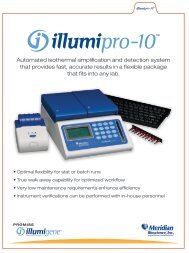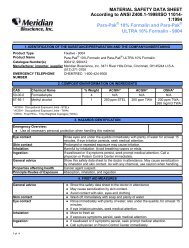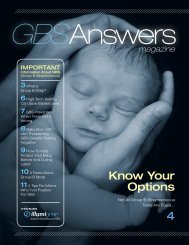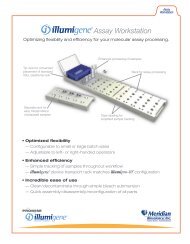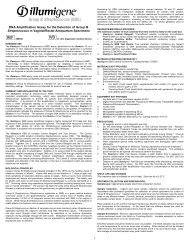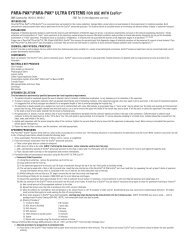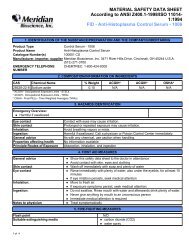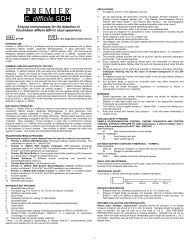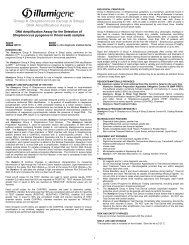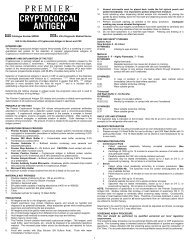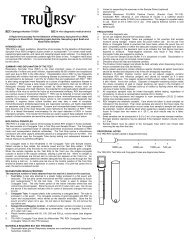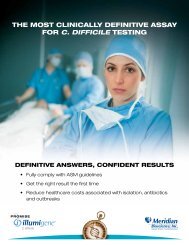1 (US Patent No. US D560281 (S1); US D5601344 (S1); US ...
1 (US Patent No. US D560281 (S1); US D5601344 (S1); US ...
1 (US Patent No. US D560281 (S1); US D5601344 (S1); US ...
You also want an ePaper? Increase the reach of your titles
YUMPU automatically turns print PDFs into web optimized ePapers that Google loves.
REPRODUCIBILITY<br />
Assay precision, intra-assay variability and inter-assay variability were assessed with a reference panel prepared from pools<br />
of negative samples spiked with specific virus. The reproducibility panel consisted of high positive (n=2), low negative (n=1),<br />
and low positive (n=4) and high negative specimens (n=4). The latter were prepared near the assay limit of sensitivity. Each<br />
reference specimen was coded to prevent its identification during testing. Each was evaluated twice per day for three<br />
consecutive days by three different laboratories. High negative samples (viral load just below LoD) produced weakly positive<br />
results in 8 out of 72 high negative replicate tests performed with the samples prepared near the cutoff (See EP12-A2, User<br />
protocol for evaluation of qualitative performance; approved guideline; CLSI, Vol. 28, <strong>No</strong>. 3, 2008). Low positive samples<br />
(viral concentration near the LoD) produced one negative result in 72 replicate tests. The high positive and low negative<br />
samples produced correct results 100% of the time.<br />
CROSSREACTIVITY<br />
The specificity of TRU FLU was tested utilizing the following bacterial, viral and yeast strains. Positive and negative<br />
respiratory specimens were spiked with ≥ 4 x 10 7 /mL bacteria or yeast. Virus inoculations were performed at ≥ 6.7 X 10 4<br />
TCID50/mL. <strong>No</strong>ne of the microorganisms tested yielded a positive result with the influenza-negative samples or interfered<br />
with detection of the influenza A and/or B positive samples. Both the negative and positive respiratory samples were positive<br />
when spiked with influenza A strain VR-100 or influenza B strain VR-295.<br />
Adenovirus Types 1, 5 and 7A, Coxsackie Type A9, Human Coronavirus Types 229E and OC43, Cytomegalovirus,<br />
Measles, Human metapneumovirus, Parainfluenza Types 1, 2 and 3, Rhinovirus Type 39, RSV (2 strains), Bacillus<br />
cereus, Bacillus subtilis, Bordetella parapertussis, Bordetella pertussis, Branhamella catarrhalis, Candida albicans,<br />
Candida glabrata, Citrobacter freundii, Enterobacter cloacae, Escherichia coli, Enterococcus faecalis, Haemophilus<br />
influenzae, Klebsiella oxytoca, Klebsiella pneumoniae, Listeria monocytogenes, Legionella pneumophila, Neisseria<br />
cinerea, Neisseria gonorrhoeae, Neisseria meningitidis, <strong>No</strong>cardia asteroides, Proteus vulgaris, Pseudomonas aeruginosa,<br />
Serratia liquifaciens, Staphylococcus aureus, Staphylococcus aureus (Cowan I), Staphylococcus epidermidis,<br />
Streptococcus (not typed), Streptococcus Groups A, B, D, F, and G, Streptococcus pneumoniae, Yersinia enterocolitica.<br />
A clinical sample containing Epstein Barr virus at 3.48 x 10 9 genome equivalents/mL was nonreactive with TRU FLU.<br />
ASSAY REACTIVITY<br />
This assay has been shown to react with the following influenza strains (in TCID50/mL): A/Victoria/3/75 (H3N2) (5.6 x 10 4 ) ,<br />
A/FM/1/47 (H1N1) (1.6 x 10 4 ), A/Aichi/2/68 (H3N2) (8.8 x 10 3 ), A/New Jersey/8/76 (H1N1) (2.8 x 10 3 ), B/Allen/45 (4.0 x 10 2 ),<br />
B/Hong Kong/5/72 (8.9 x 10 4 ), B/Taiwan/2/62 (3.5 x 10 1 ), B/Russia/69 (1.1 x 10 4 ). This assay was also shown to react with<br />
the following avian/swine influenza A subtypes (by HA Titer): H1N1 (51), H2N2 (6), H3N2 (13), H4N8 (13), H5N2 (51), H5N3<br />
(51), H5N9 (205), H6N8 (13), H7N2 (26) and H9N2 (26). The following H5N1 strains were shown to react with this assay (in<br />
TCID50/mL): A/Vietnam/1203/04 (2.9 x 10 3 ), A/Hong Kong/486/97 (3.6 x 10 5 ), A/Hong Kong/483/97 (2.3 x 10 5 ). Refer to the<br />
Analytical Sensitivity Section of this instruction for additional influenza strain reactivity information.<br />
NOTE: Although this test has been shown to detect cultured avian influenza viruses, including avian influenza A<br />
subtype H5N1 virus, the performance characteristics of this test with specimens from humans infected with H5N1<br />
or other avian influenza viruses are unknown.<br />
TESTS FOR INTERFERING SUBSTANCES<br />
The following substances were found to have no effect on results when present in respiratory samples at the concentrations<br />
indicated: Acetylsalicylic Acid (20 mg/mL), Acetaminophen (10 mg/mL), Halls® Throat Drops (20 mg/mL), Ludens® Throat<br />
Drops (20 mg/mL), Ricola® Throat Drops (20 mg/mL), Diphenhydramine (5 mg/mL), Dextromethorphan (9% v/v),<br />
Phenylephrine hydrochloride (9% v/v), Oxymetazoline hydrochloride (9% v/v), Chlorpheniramine maleate (5 mg/mL),<br />
Ibuprofen (10 mg/mL), Clemastine fumarate (5 mg/mL), Naproxen sodium (10 mg/mL), Loratadine (5 mg/mL),<br />
Pseudoephedrine (20 mg/mL), Listerine® Mouthwash (9% v/v), Scope® Mouthwash (9% v/v), Cepacol® Mouthwash (9%<br />
v/v), Whole blood (0.5%), Guaifenesin (9% v/v), Albuterol (9% v/v).<br />
Information regarding other tests performed with TRU FLU that are not described here can be obtained from Meridian’s<br />
Technical Support Services at 513-271-3700 or 800-343-3858.<br />
10



